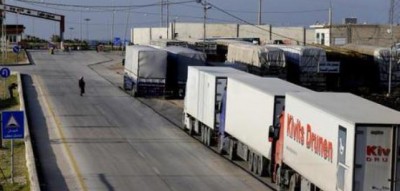Jordan’s Role in Syria Border-Crossings of Islamist Rebels, Saudi and Qatari Weapons Transfers

Although Jordan has claimed that it is neutral in the conflict between the forces that are loyal to the Syrian government and the Islamist rebels, many news outlets have reported on the active Jordanian support to the latter.
In November 2011 the Jordanian king Abdullah II was the first Arab leader that called for the Syrian President Assad to step down.
Late 2012, the Jordanians open up their borders for Qatari and Saudi weapon transfers and US CIA camps were set up on Jordanian soil in order to train rebel forces.
After a joint military exercise with US armed forces, Jordan requested the US to leave their Patriot Missile Defense system and several F-16 jet fighters in Jordan to bolster the border region.
Washington has granted this request, as well as stationing hundreds of US soldiers in the country to ‘maintain the Patriot batteries and F-16 fighters’.
All this played into the Islamist rebel hands when they launched their Daraa offensive in march 2013 targeting the Syria-Jordan border region.
Their offensive proved to be quite successful, as they captured most of the northwestern border area.
Although a counterattack by the Syrian Army undid some of their success, the border region remained in the hands of the militants groups.
In December 2013 the Daraa border crossing was captured by the Islamist rebels and in April 2015 the second and last border crossing (Nassib) with Jordan was captured by a contingent of Free Syrian Army and the Al Qaeda linked Al-Nusra Front.
Still there is a gap of roughly a year between the moment Jordan opened up its border for Qatari and Saudi weapon transfers and the actual capture of the first border crossing by the Islamist rebels.
A look on historical satellite footage of the border region shows how Jordan has supported the creation of illegal border crossings with Syria and even assisted in constructing/supporting these crossings.
The first area we will look at is at the Syrian border town Tell Shihab (figure 1). During the earlier stages of the Syrian conflict, this border town was captured by the opposition forces.

Figure 1: The Tel Shibab border area in late 2009.
Figure 2 shows the development of the border area west of Tel Shibab. In 2011 during the initial stage of the conflict walk tracks appear at the border. According to activists this will probably be refugees going to Jordan, but it is very likely this also includes weapon smugglers heading towards Syria. In the same figure one can see a road being constructed between 2011 and halfway 2013. While the road is being constructed, Jordan also reinforces its own border post.

Figure 2: Zoomed in on the Jordanian-Syrian border near Tel Shibab, showing the development of an illegal border crossing
Figure 3 shows the development of the road and its surrounding. Again one can see that Jordan reinforces its side of the border with dirt walls/tank barriers in 2013. The road that crosses the border is finished in 2014 and seems heavily used. Also, the road on the Syrian side of the border has been altered to decrease the hinder due to the curve, while the Syrian border post has been altered as well (might be destroyed).

Figure 3: Zoomed in constructed illegal border crossing near Tel Shibab.
Figure 4 shows the border area south of Tel Shibab. In 2011 this area features a Jordanian border guard station with a lookout. As with the earlier figures, you can clearly see walking tracks in the border zone. Between 2011 and halfway 2013 the area is developing. Two roads appear at the border guard station and another hub is being built just east of it. In 2014 the main road received new tarmac, ending at the border station (could this be related to heavier equipment being transported to the area?). Figure 5 shows he situation at this border post in 2014. Note the vehicles on the Syrian side of the border and the continuing development of the border sites.

Figure 4: The Border guard station south of Tel Shibab

Figure 5: Zoomed in on the Border guard station south of Tel Shibab in 2014.
Figure 6 shows the development of another border guard station and another illegal border crossing between Jordan and Syria.

Figure 6: East of Figure 4 and 5, another Border guard station and another illegal border crossing being developed between 2012 and halfway 2013
Southwest of the Nassib border crossing is another example of the development of an illegal border crossing under the watchful eye of the Jordanian army (figure 7 and 8).

Figure 7: Southwest of the Nassib border crossing another illegal border crossing was constructed

Figure 8: Southwest of the Nassib border crossing another illegal border crossing was constructed between 2012 and halfway 2013.
As demonstrated in this article, numerous illegal border crossings on the Jordanian-Syrian border were constructed under the supervision of the Jordanian state.
The moment of construction coincides with the reports that Jordan at the end of 2012 opened up its border for Qatari and Saudi arms destined for Islamist rebels in Syria.
It also coincides with the start of massive opposition offensives on the Daraa front.
Take note that at that specific moment, the Daraa and Nassib border crossings were still in the hands of the Syrian state.
This means the only way equipment and (foreign) militants could have crossed the border in preparation for these offensives is through these illegal border crossings, under the watchful eye of the Jordanian state.
At the moment of writing, the Syrian Army is advancing towards the Daraa border crossing. But apparently this will be only one of the many current border crossings the Islamist rebels can use to transfer weapons, aid and personnel.

